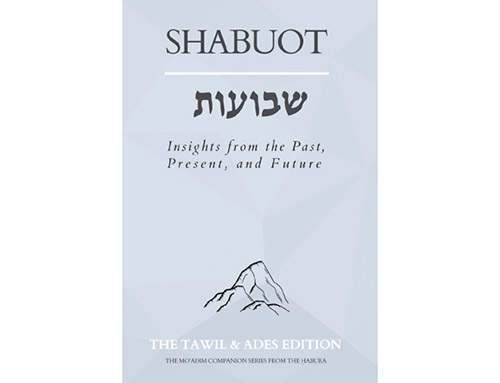
Reviewing: “Shabuot: Insights from the Past, Present, and Future” by The Habura. Independently published. 2023. English. Paperback. 261 pages. ISBN-13: 979-8392495160.
Middle-child syndrome is based on the notion that your birth order directly impacts your development. The middle child doesn’t have the glamor of being the oldest or the novelty of being the youngest, and is trapped in the middle netherworld.
In some ways, the festival of Shavuous is like the middle child. The other two holidays are replete with symbolism. While Pesach has matza and Sukkos has the four species and a sukkah, Shavuous does not have as much.
What Shavuous lacks in outward symbolism, it has a corresponding amount of internal symbolism. And two recent books bring that to light.
The Habura (www.thehabura.com) describes itself as an online and global bet midrash dedicated to studying, teaching and publishing Torah as a lens through which we view and interact with God’s world. Their approach is rooted in, but not exclusive to, the classical Sefardi tradition. I reviewed their excellent volume on Pesach last year.
Led by the dynamic Rabbi Joseph Dweck, senior rabbi of the U.K. Spanish and Portuguese community, The Habura just published “Shabuot: Insights from the Past, Present, and Future.” This volume contains 19 essays from various Habura members. They run the range from erudite scholars like Rabbi Dweck to lay members of the community.
One person prominently profiled in this fascinating volume is the much-maligned and under-appreciated Hacham Jose Faur, zt’l. A number of the authors reference his fascinating insights, while his son Rabbi Abe Faur quotes his father extensively in his brilliant essay on how Torah is incompatible with natural law.
A perceptive essay by Rabbanit Dr. Devorah Halevy contrasts the models of Torah education in the Sephardi and Ashkenazi communities. A recent report from the Commission of Jewish Education in North America notes that many problems plague the system of Jewish education. Because of its inadequacies, it is failing to engage the minds of the critical segment of the Jewish population who have no other way of experiencing the richness and beauty of Jewish life.
Far from being a new problem, Halevy quotes the Maharal, who, in the 16th century, wrote that the schools were teaching young children Talmud when they had no ability, interest or previous foundation on which to integrate the information properly. The Maharal wrote that the correct approach is to plant the tree with roots first, so that it can support the leaves. Instead, things were done upside down.
The second half of the book is essays from lay leaders. This includes an insightful essay about Shavuous in the context of the ancient Near East by Sina Kahan and an essay on Yemenite customs on Shavuous by Daniel Dor-Chay.
While many people, myself included, thought of the Yemenite community as somewhat monolithic, he writes that it is indeed a common mistake to assume the Yemenite community was homogenous. There were actually hundreds of Jewish communities spread across Yemen’s 200,000 square miles, from Aden in the south, to Najran in the far north, in what is now modern-day Saudi Arabia, to Tarim in the Hadramaut desert in the east. Each community had its own unique customs.
While The Habura may be based in London, this interesting volume opens their bet midrash to everyone.
—–Rabbi Joseph Soloveitchik said that if he were to add to Maimonides’ 13 Principles of Faith, his 14th principle would be that the values and legal constructs of the Torah are timeless and have absolute relevance to every generation and location.
In “The Tripod: A New Perspective on the Shalosh Regalim” (Mosaica Press), Rabbi Neil Lauer shares his insights and experiences, often using his life experiences on the New York City transit system. Through this, he shows, as Rav Soloveitchik observed, that the Torah’s significance is more relevant than ever.
Each of the Shalosh Regalim serves to preserve past miraculous events by creating experiences that replicate elements of the original miracle for a person to participate in firsthand.
The book heavily uses tables, which Rabbi Lauer uses to show the connections and relationships between the three festivals and provide deeper insights into them. The three festivals, in general, and Shavuos specifically, have numerous elements that are often overlooked. The book focuses on these and gives the reader a deeper look at them, leading to a better appreciation of the holidays.
While the Torah was given over 3,300 years ago, Rabbi Lauer’s insights show how the Torah can be just as relevant now, as it was when it was given. Buy it for Shavuous, and savor the insights.
Ben Rothke lives in New Jersey and works in the information security field. He reviews books on religion, technology, philosophy and science. Follow him on Twitter at @benrothke.









